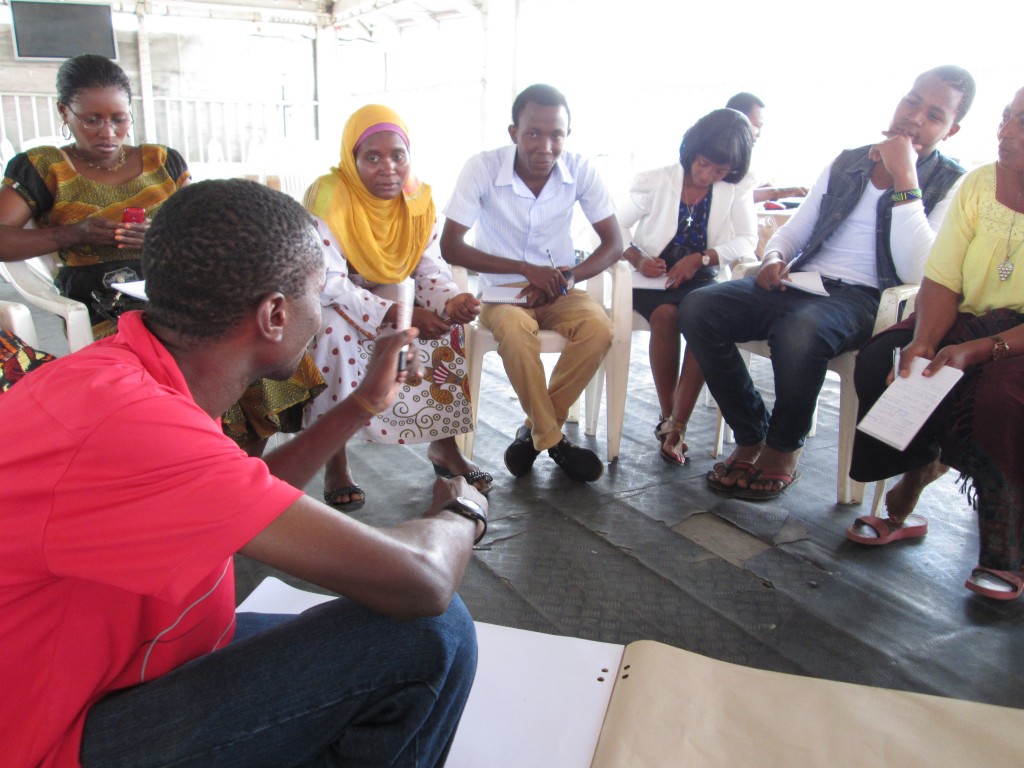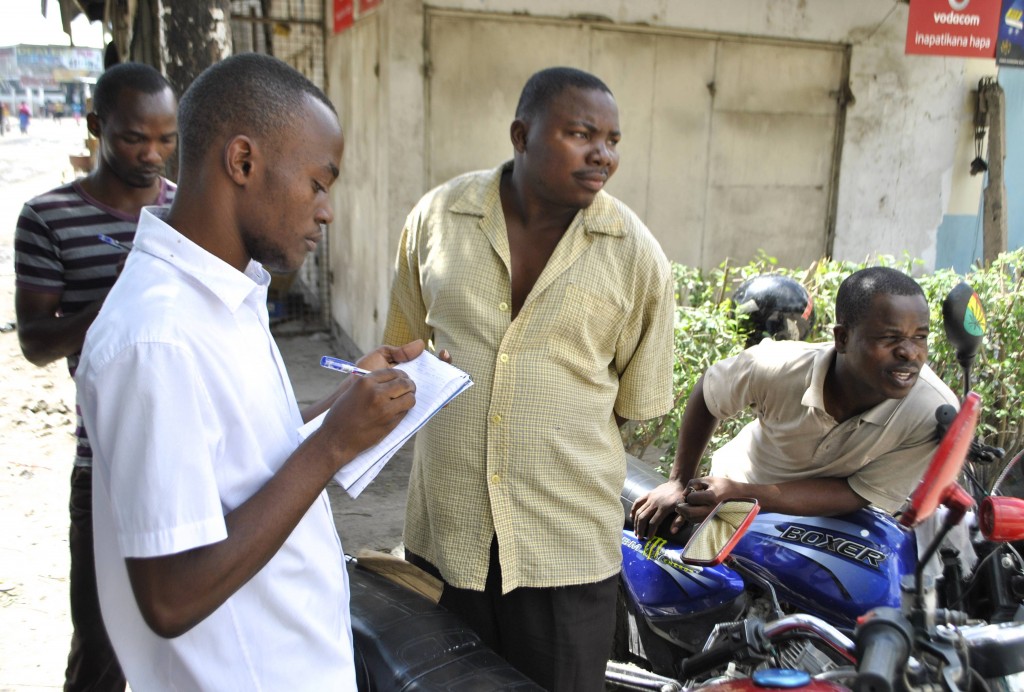GroundTruth in Dar es Salaam: Six Lessons for Effective Feedback Loops
Posted: August 30th, 2013 | Author: Erica Hagen | Filed under: citizen feedback, tandale, Tanzania | 2 Comments »Closing the Gap with Decision Makers
I was recently in Dar es Salaam, Tanzania, examining the potential for a “feedback loop†in some of the regions where GroundTruth has worked, particularly in Tandale, and Keko Machungwa, two informal settlements.
GroundTruth hasn’t had a formal program running in Dar, but since our mapping project in 2011 we’ve supplied the community group with computer equipment and supported a local student participant, Msilikale Msilanga, to help out on a regular basis, resulting in a fantastic community blog. We also provided some technical support to the local chapter of Slumdwellers International to do their own mapping in Keko Machungwa.
The information outcomes in both pilot areas have been quite impressive—they are much more visible now, and community members can work with information in ways that it’s usually assumed only experts can manage. But we also knew that the potential for transformation on the ground would require, at a minimum, closing the gap between the community and those who could respond to their needs.
While there, I worked with volunteer Brielle Morgan and Msilikale to provide extra training for the key Tandale bloggers, and to help the group in Keko create their own blog. Then, we discussed the specific goals they wanted to achieve through their information work, their motivations, and how they imagined the information would loop with decision makers and produce the desired ground-level action. I took some of the same questions to meetings with local government officials, NGO leaders, urban experts at the World Bank, and other advisers.
In each community, we came up with a target issue that they wanted to work on through reporting/mapping. In Tandale, it was building a secondary school.
We had an amazing moment where Msilikale showed the group a map of all the local schools, and they were able to demonstrate where their children must travel to attend school—extremely far! This information could well support a push to build a new local school.
Creating a Full-fledged Loop
I’m not sure if you can see the way this project “could†go and become a full-fledged loop, so I’ll detail it first:
- Reports/information lead down a media and publicity path—a wider audience is brought to the blog and maps, and therefore to the community, generating a potential interest by mainstream media. Government response follows due to public demand.
- Reports reach to particular target actors in government. Key community members who participated in the reporting make the information known to those key people, along with those of us working at a higher level. The combination of targeting the right person/people, and having high quality information and clear goals, leads to the desired outcome
- Reports influence the community itself to take actions, such as, not throwing trash in the river, or addressing various other public problems.
Six Lessons:
Here are six lessons we can take from the experience of learning how to create an effective information circle that allows local voices to be heard, and increases the impact of the grassroots information activists.
1) Context Matters (maybe more than anything else)
While this sounds more than obvious, I don’t think it gets nearly enough prominence in technology and development projects in general. It’s a top consideration.
Our Dar example illustrates this well: while it’s just next door to Kenya, it’s a world apart. So while in Kenya we’ve looked at how to work closely with community organizations and NGOs to achieve changes, collaboratively assessing information needs, in Tanzania, most people recommend working directly with government officials. Civil society organizations are comparatively few and far between. This is a pretty fundamental difference when it comes to planning the trajectory of your information or advocacy.Â
In Kibera, it’s best to build a coalition of local groups and individuals that have an interest in the topic you’re working on, and slowly build toward incorporating government and larger organizations. But in Tandale, meet directly with the local MP and mayor, ward officers, and individuals from the community.
2) Deciphering the political context isn’t something most people know much about
If you expect your average participant (or even average organization) in a feedback loop to understand the political system well enough to navigate through it, you’ll probably be disappointed. In Dar, the expectation was often that “the right people will listen and do something†if we collect and publicize local information and needs.
Part of working in this space means helping people find out how things actually work, and what they can do to have a stronger impact.
But this doesn’t mean you should do the connecting yourself, or determine the pathways independently of the group you’re working with. It’s about partnering, not leading. This is when teaching the skills needed for investigative journalism can come in handy—why, exactly, isn’t there a secondary school yet in Tandale? Who can I talk to and ask?
Once you ask people to begin to scratch the surface of an issue, you realize that people aren’t often comfortable asking such questions. Our groups in Dar were not sure whether those important key people would be willing to talk to them at all (and maybe they would not). But this is a good problem to have—it’s where things get interesting, especially once people begin to cross these perceived boundaries. Partners that are knowledgeable about advocacy and those with a “convening†ability are fantastic to bring in at this point.
3) Don’t assume you know people’s motivations for participating
Here are some examples of what people said about their reasons for writing the Tandale and Keko blogs:
“We’re expecting someone to see our problems and help us.â€
“We want Tandale to be known.â€
“To learn computer skills.â€
“With the map, instead of someone coming in to tell you, you can see what is needed for yourself. We can use the blog to share this in a story with photos and locations. The community as a whole will see and take action. It will also allow us to interact with all levels of government. We can defend our ideas with information.â€
As you can see, the last respondent has a much more nuanced idea of what they hope the information can do—thanks to her experience working on community issues in a leadership role. She anticipates playing an active role to get the information where it needs to go—whether out to the wider community, or targeting it to particular members of government.
But the other responses are also important. The desire to be “seen,†in particular, is something we often hear, and it gets into deeper issues of social standing and subtle ways of raising the status of people in a community—toward the longer-term goals of increasing their power in society. An invisible or unheard person/community is easily ignored.
4) Feedback is fundamentally a social process—not individual
This reinforces what we’ve learned elsewhere—there is a group or social aspect to reporting and using information that is different from what we tend to do in the United States. Belonging to a group that is working toward a shared goal, and having physical contact with the group members is critical. Which means . . .
5) Organizations matter
We’ve learned this over and over again, but it’s still left out (or wished out) of the planning process, much of the time. While GroundTruth started working in Tanzania with partners like the World Bank, Twaweza, and Map Kibera, on the ground we had a group that consisted of university students, community members, and members of the Slumdwellers federation.
Would this group coalesce into something that enables the feedback loop to sustain into the future? Not on its own. Institutionally ungrounded pilots are simply not going to succeed. It was a fantasy initially that a large university would play that role. Grounding must come from close to the ground.
We’ve essentially provided this for the initiative until this point. So during my trip, I revisited the topic of ownership and how to support community members who were so enthusiastic about the potential of the mapping and blogging. I had a great talk with the leader of a civil society organization umbrella group about how to institutionalize a project in a place with few capable non-governmental organizations.
But it often boils down to…
6) Sustained funding matters: pilots and experiments need time to bear fruit
We need to be able to work intensively, over a long enough period of time, until a paradigm shift begins to happen. This requires not one-off pilot funding, but sustained funding over a couple of years.
Then, and only then, you’ll start to see real results. We’ve been at this for three years in Dar es Salaam, and we’ve seen amazing persistence by the participants, but less than inspiring funding opportunities.
We’ve seen contests and hackathons and government-led initiatives, but not investment in the very people who are on the cusp of effectively changing the way citizens relate to their government.
You might wonder how a few blogs are going to change the face of participation in development. This probably sounds very piecemeal and unscalable or whatever other impatient adjectives. But the final question remains:
Is building a large, all-encompassing feedback system through government going to be what works in this new frontier of development, or is it going to be the messy process of engagement at the grassroots and people’s own experimentation with and ownership of technology that ends up having a chance to finally flip the development paradigm on its head?
I will go into this in more depth in a follow-up blog post coming soon.




[…] am Erica Hagen and in a recent post, I talked about how effective feedback loops are close to being realized in Dar es Salaam. In this […]
[…] GroundTruth in Dar es Salaam: Six Lessons for Effective Feedback Loops – GroundTruth Initiative […]